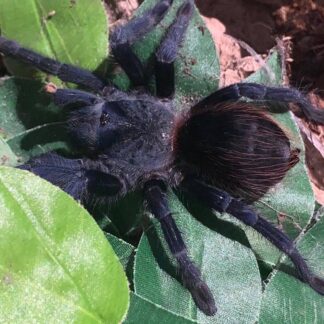Description
**Species Spotlight: Tliltocatl schroederi – Mexican Black Velvet**
Welcome to the fascinating world of tarantula keeping, where enthusiasts are captivated by the diverse and captivating species that inhabit our planet. In this edition, we shed light on the intriguing Tliltocatl schroederi, more commonly known as the Mexican Black Velvet, a captivating arachnid native to the Valles Centrales de Oaxaca state of Mexico.
**Species Profile:**
– *Taxonomy:* Tliltocatl schroederi (formerly known as Brachypelma schroederi)
– *Common Name:* Mexican Black Velvet
– *Origin:* Mexico
– *Habitat:* Savannas and scrublands
**Physical Characteristics:**
This species, although not prevalent in the hobby, boasts a distinct allure. Mexican Black Velvet tarantulas are of medium size within the genus, with males measuring around 34–36 mm and females significantly larger at approximately 48 mm. Their dark brown to black coloring distinguishes them, lacking the characteristic red hairs seen in related species. Notably, males have a longer fourth leg, measuring about 61 mm, while females measure around 47 mm.
**Behavior and Habitat:**
Mexican Black Velvet tarantulas exhibit intriguing behaviors. They are opportunistic burrowers, and as they mature, they tend to spend more time in the open, making them an excellent choice for enthusiasts seeking a captivating display tarantula. Their habitat in the wild includes savannas and scrublands.
**Care Guidelines:**
*Temperature and Humidity:* Maintain temperatures between 70°-85°F (21.1°-29.4°C) with humidity levels ranging from 65% to 80%. A suggested temperature of 80°F (26.6°C) and 65-70% humidity in captivity is recommended.
*Enclosure:* Utilize a spiderling vial with at least three inches (7.62 cm) of substrate for burrowing, increasing to four inches (10.16 cm) as they reach sub-adult to adult stages.
*Substrate:* Employ a substrate mixture comprising peat moss, vermiculite, coconut fiber, and dirt for firmness.
*Retreat/Hide:* Provide a bark hide for burrowing, especially for spiderlings.
*Feeding:* Begin with fruit flies and progress to baby crickets as they grow. Adults can be fed two B. dubia roaches or ten adult crickets weekly.
*Water Requirements:* Maintain a water dish in the enclosure, even though direct observation of drinking might be rare.
**Life Cycle:**
The growth rate of Mexican Black Velvet tarantulas is moderate. Starting as 1/2″ (1.27 cm) spiderlings, they can reach three inches (7.62 cm) within three years under optimal conditions. Adults typically reach sizes around four inches (10.16 cm).
**Temperament:**
This species is known for its docile nature. Rarely displaying threat poses or defensive behaviors, the Mexican Black Velvet makes for an excellent choice for tarantula enthusiasts of all experience levels.
**Conclusion:**
The Mexican Black Velvet, Tliltocatl schroederi, stands out not only for its captivating appearance but also for its manageable care requirements. As a species less commonly found in the hobby, it offers enthusiasts a unique and rewarding tarantula-keeping experience. Considered an easy-to-care-for tarantula with a calm demeanor, this species is a gem waiting to be discovered by tarantula enthusiasts around the world.




